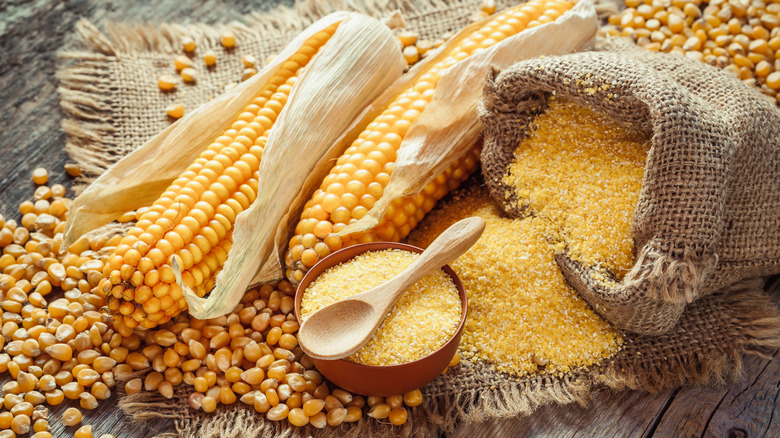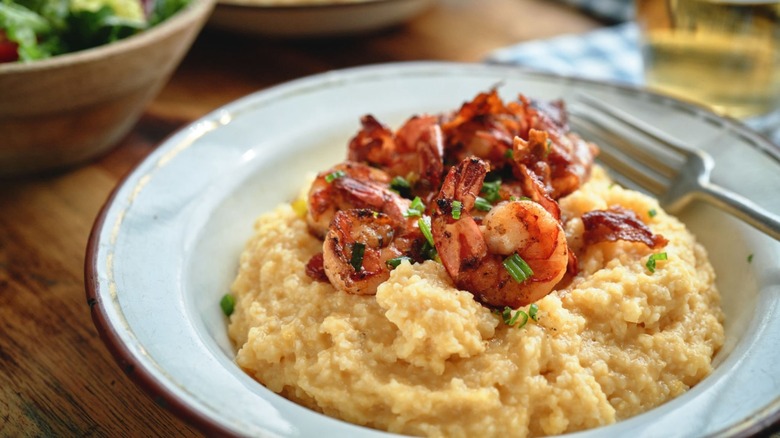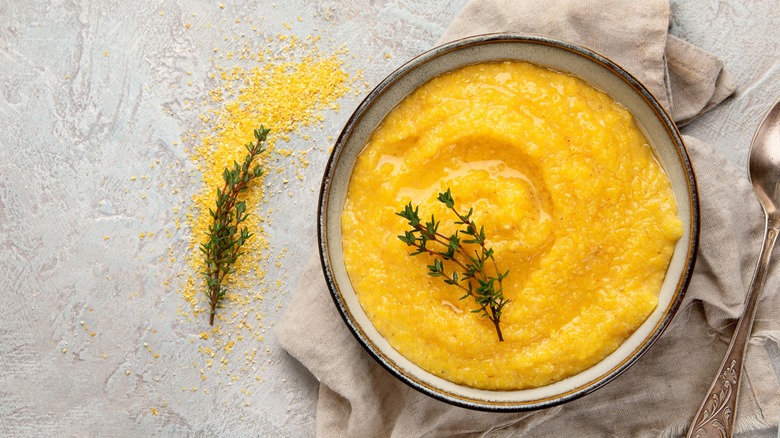Grits Vs. Polenta: What's The Difference?
Grits and polenta represent just two regional variations on one of the oldest and most universal food traditions in the world: porridge. Grains or cereals cooked in liquid have served as a staple dish for thousands of years, with NPR reporting that their ease of growing and storing, plus high levels of nutrition, made them a favorite from the Roman Empire all the way across the continent to ancient China.
Throughout this diverse heritage, a warm, comforting bowl of porridge has taken on many forms, from east Asian rice dishes like congee to rye in Europe, and lentil porridge in India. Whatever form they take, their cheap easy versatility has kept the different variations of porridge popular to this day.
As anyone who enjoys a warm bowl of oatmeal on a cold winter's day can attest to, porridges hold a place in cuisine beyond practicality. Porridge's simplicity and heartiness make them a popular comfort food wherever they're found, and few variations are more comforting than grits or polenta. They are both creamy, filling staples that can be eaten on their own or serve as a base for other homey toppings like eggs, cheese, or stewed meat. They also stand out from other porridges because they're made from corn.
While they are similar in a lot of ways, grits and polenta don't produce the exact same eating experience, and those differences come from the regional variations in how they are prepared.
What are grits?
Like polenta, grits are ground corn, but they are made from starchy, mildly flavored varieties called dent corn. Food Network states that grits can be made from either yellow or white corn, with yellow varieties tasting more like corn and white tasting more neutral. Grits originated with Native Americans but are now primarily associated with the cuisine of the American South, and are served as a side or used in southern favorites like shrimp and grits. Real Simple notes that since grits have a subtle flavor, it's most common to cook them with richer ingredients like butter, milk, cream, or cheese.
Beyond the variety and color of corn, differentiating grits from polenta gets harder because grits come in a number of styles. The most traditional style of grits is stone-ground, which has a coarser grain, takes longer to cook, and produces a more textured and toothsome bite. There are also quick-cooking and instant grits, which are finer ground, producing a creamier dish, but with less flavor than stone-ground.
The last main style you will see on the shelf is hominy grits. They are made in a way similar to masa: soaked in a chemical lime solution and stripped of their hull before being ground, which produces a stronger corn flavor. While mainly thought of as a savory dish outside the South, grits can also be finished with a bit of sugar or honey and eaten as a sweet dish.
What is polenta?
Polenta is an Italian dish made from ground cornmeal, and it serves a lot of the same purposes in Italian cooking as grits do in Southern cuisine. According to Serious Eats, polenta goes back to the Roman Empire, when it was made with other grains like barley, only transforming into a corn dish after maize was brought over to Europe from the Americas.
MasterClass states that it's made from flint corn instead of dent, which means it is less starchy, and polenta grinds keep more of the corn husk instinct, lending it a more robust flavor and texture. Its texture, like the different styles of grits, varies, but it tends to be coarsely ground, although not quite as coarse as stone-ground grits are.
Unlike the more rich U.S. cousin, polenta is made mainly with water or stock. A pat of butter or some milk is still welcome, but less traditional, giving polenta a more corn-forward, rustic flavor. It's also common for leftover polenta to be cooled and formed into logs, which can then be pan-fried as a crispy snack. Any version of polenta is going to taste great topped with the sauce you normally use for pasta, whether it's a rich Bolognese or eggplant and tomato sauce. As long as you prepare grits or polenta properly, you'll be rewarded with a wholesome, filling meal that would make any grandmother, Southern or Italian, proud.


